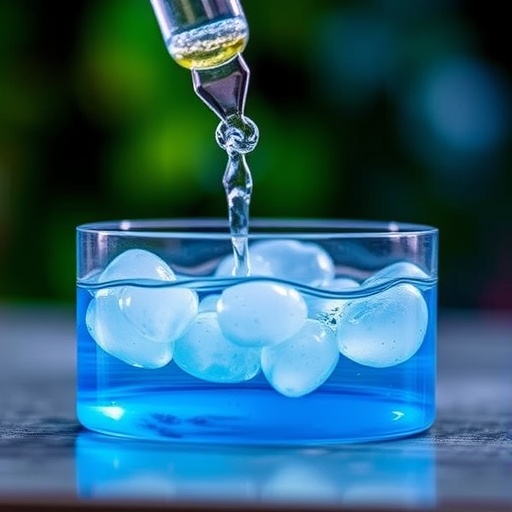In the rapidly evolving field of sustainable energy conversion, the challenge of efficient carbon dioxide (CO₂) electrolysis remains a formidable hurdle. Central to this challenge is the development of novel materials and systems that can facilitate the conversion of CO₂ into valuable chemicals and fuels with minimal energy loss. Recent research published in Nature Chemical Engineering by Prats Vergel, Mu, Kolobov, et al. (2025) ushers in a new understanding of reverse-bias bipolar membranes (BPMs) and their critical role in CO₂ electrolysis. The core finding—that water dissociation efficiencies directly impact the viability of reverse-bias bipolar membranes—presents a pivotal advancement poised to reshape carbon capture and utilization technologies.
Reverse-bias BPMs have increasingly attracted attention for their potential to optimize the electrochemical environment required for CO₂ reduction. Unlike traditional membranes that face limitations in ion transport and stability, reverse-bias BPMs present a promising architecture that separates ionic species with high selectivity while supporting proton flux essential for driving electrolysis reactions. However, for these systems to reach their full potential, efficient water dissociation at the membrane interface is paramount. The study highlights how this fundamental chemical process governs membrane performance, which in turn dictates overall system efficiency and durability.
The team delved deep into the electrochemical mechanisms underpinning water dissociation at the bipolar interface—where the anion exchange layer meets the cation exchange layer within the BPM structure. This localized phenomenon is essential because it produces the protons and hydroxide ions required to maintain charge neutrality during CO₂ reduction. By optimizing this dissociation step under reverse bias conditions, researchers found that the rate and extent of ion generation could be finely tuned, significantly enhancing the membrane’s operational stability and electrochemical activity.
Crucially, the authors employed a suite of advanced experimental techniques combined with theoretical modeling to unravel the interfacial kinetics of water splitting. Electrochemical impedance spectroscopy offered insights into charge transfer resistances and capacitive behaviors, revealing how water dissociation efficiency directly correlates with membrane voltage losses. Complementing experiments with density functional theory calculations allowed the team to elucidate atomistic details about proton transfer pathways, shedding light on how membrane composition and microstructure influence catalytic activity at the interface.
This mechanistic understanding translates into practical considerations for membrane engineering. By manipulating the chemical composition—particularly the nature and density of functional groups in the ion exchange layers—the researchers achieved enhanced catalytic sites that lower the energetic barrier for water dissociation. This not only improves ion transport but also reduces membrane degradation phenomena commonly observed under high current densities during prolonged CO₂ electrolysis operations.
Moreover, this work advances the broader context of carbon capture and utilization by addressing a bottleneck frequently overlooked: the interplay between membrane design and water dissociation energetics. While previous efforts often emphasized electrocatalyst development, Prats Vergel and colleagues underscore the equally vital need to tailor electrolyte environments and membrane interfaces. This holistic approach may pave the way for integrated systems that combine BPMs with next-generation catalysts to unlock higher conversion efficiencies and product selectivities.
The implications are profound considering the global urgency to transition towards a carbon-neutral society. Improved BPMs capable of operating efficiently in reverse bias could enable lower energy input requirements, reducing the carbon footprint associated with CO₂ electrolysis. By enabling more effective water splitting within the membrane, such devices can sustain higher current densities without sacrificing longevity—an essential factor for commercial scalability and economic viability.
In addition to enhancing membrane architectures, the study suggests opportunities to integrate novel materials such as heterogeneous catalysts, ionomers, and nanostructured layers that may further accelerate water dissociation kinetics. This multifaceted research trajectory likely will inspire a wave of innovation in membrane science, targeting not only CO₂ reduction but also applications like fuel cells, water electrolysis, and electrochemical sensors.
The investigation also sheds light on the role of operational parameters—including applied potential, pH gradients, and temperature—on the water dissociation performance of reverse-bias BPMs. Understanding how these external factors modulate membrane behavior can inform the design of adaptive electrolyzers that optimize conditions in real-time, maximizing throughput and minimizing energy wastage.
Equally important is the stability dimension addressed in the publication. Water dissociation centers, if not carefully engineered, may become sites of polymer degradation or ionomer crossover, compromising membrane integrity. The authors’ insights into maintaining a delicate balance between activity and durability will guide future fabrication protocols aimed at producing robust BPMs capable of sustained operation under harsh electrochemical environments.
This groundbreaking study redefines the landscape of CO₂ electrolysis technologies by illuminating a key, controllable parameter at the membrane interface. As the world looks towards scalable solutions for greenhouse gas mitigation, such fundamental advancements in membrane chemistry will be instrumental in bridging the gap between laboratory-scale prototypes and industrial reality.
Ultimately, the work by Prats Vergel and collaborators presents an inspiring example of science driving innovation in clean energy conversion. By focusing on the unsung hero of electrochemical devices—the bipolar membrane—they open new avenues for transforming carbon emissions into valuable chemical feedstocks, moving society a step closer to a sustainable future powered by renewable energy sources.
Subject of Research: The role of water dissociation efficiencies in the performance and viability of reverse-bias bipolar membranes for CO₂ electrolysis.
Article Title: Water dissociation efficiencies control the viability of reverse-bias bipolar membranes for CO₂ electrolysis.
Article References:
Prats Vergel, G., Mu, H., Kolobov, N. et al. Water dissociation efficiencies control the viability of reverse-bias bipolar membranes for CO₂ electrolysis. Nat Chem Eng (2025). https://doi.org/10.1038/s44286-025-00306-7
Image Credits: AI Generated
DOI: https://doi.org/10.1038/s44286-025-00306-7
Tags: advancements in chemical engineering for sustainabilitycarbon capture and utilization advancementsCO2 electrolysis efficiencyelectrochemical systems for CO2 reductionenergy loss in carbon conversionionic species separation in electrochemistrymembrane performance in electrolysisnovel materials for energy conversionproton flux optimization in membranesreverse-bias bipolar membranessustainable energy conversion technologieswater dissociation in electrolysis





